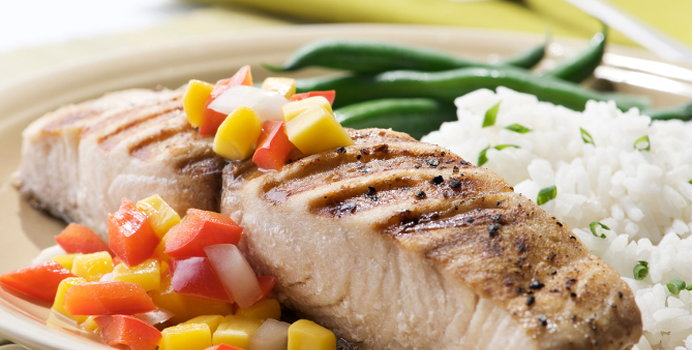Before you head to that restaurant or stock your freezer, here are some good features, bad features and warnings of the different types of sea life there is to add to one's diet:
Some of the main seafood categories include: Fish, roe (fish eggs), crustacean shellfish and mollusks.
Fish
Pros: Most of the domestic fish such as tuna, salmon, cod, are good sources of protein, B vitamins, and potassium, magnesium, selenium and other minerals. This is a versatile protein food source that also is relatively low in fat. Salmon, anchovies and whitefish have the highest Omega-3 fatty acid content. This type of fat is very good for cardiovascular, brain and joint health, to name a few.
Cons: But there's fishy sides to the story. According to the Food Allergy and Anaphylaxis Network, more than 2 percent of Americans report an allergy to fish and shellfish, with salmon, halibut and tuna being the most likely to cause the reaction. Some of these reactions can be severe and/or lethal.
The bigger fish is, the more chance of contamination by mercury and other toxins such polychlorinated biphenyls (PCBs). The ones to avoid or eat sparingly are swordfish, tilefish, king mackerel, blue fin tuna, domesticated shark, and marlin.
Undercooked or raw fish can contain many kinds of parasites (including tapeworms). Be sure the seafood was commercially deep frozen and/or heated to at least 140 degrees to kill tapeworms and other parasites. It's important for pregnant women, babies, young children and immunity-compromised persons avoid these types of fish.
Wild caught fish such as salmon have more advantages over farm raised in that the fish are in their normal environment and not overcrowded or negatively affected by human intervention.
Roe (Includes fish eggs such as caviar)
Pros: This type of seafood is a very good source of protein and other nutrients for the serving size (about 4 grams in two tablespoons in caviar for example).
Cons: Some types of roe, such as caviar, are higher in cholesterol and sodium and may still have parasites.
Crustaceans (Include crab, crawfish, and lobster.)
Pros: Omega-3 and mineral content is high in this low-calorie food.
Cons: High in sodium, one crab leg can have more than 1,000 mg of sodium.
Undercooked crabs and other types of crustaceans and fish and even roe can contain many kinds of parasites (including tapeworms
Mollusks
Pros: Domestic shrimp, oysters, snail, clams, squid, conch and scallops are very nutritious with B vitamins, minerals and protein. They are very versatile seafood that can be prepared many ways.
Cons: Imported shrimp and scallops may have unwanted additives and can also contain parasites if undercooked
There's an ocean out there to learn about seafood, its safety and nutrition. It's worth it to increase your knowledge of this area of the food chain before reeling in dinner!
Catherine S. Hains, MS RD has been interested in health and nutrition since she was a young child. Growing up in Fort Worth, TX, she earned a Bachelor's Degree in Broadcast Journalism from Texas Christian University and wrote for the Fort Worth Star-Telegram for 12 years. Her life-long interest in nutrition and disease prevention never waned, and she went on to earn her Master's Degree in Nutrition from Eastern Michigan University. Cathy, now a Registered Dietitian, owns Lighthouse Nutrition and Wellness in Gig Harbor, WA where she enjoys inspiring people of all ages to make losing weight and living a healthy lifestyle easy, fun and permanent. She enjoys good food, cooking and food preparation, and showing others how healthy this can be. Her other pastimes include traveling, art, music and family life. She also likes staying fit with tennis, bicycling walking and jogging, researching nutrition and helping clients be at their best. For more information on Cathy, visit www.lighthouse-nutrition.com or write to Catherine at [email protected].



